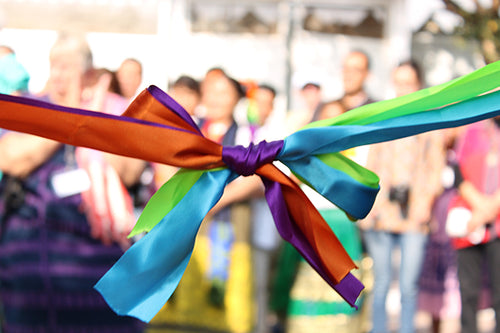EXPERIENCE OAXACA
9 ESPIRITUS MEZCAL & KALAKAS CHILE LICOR AND OAXACA MIO — Essentials for Oaxacan Cuisine
Feria Maestros del Arte
is pleased to welcome
9 Espiritus Mezcal & Kalakas Chile Licor
&
Oaxaca Mio
to our 2023 Feria

It is often said that the Feria is not just an art show, it is a “heart” show. When we were looking for a mezcal to present at the Feria, we had never heard of 9 Espiritus Mezcal. After reading “12 Special Edition Bottles —A Tribute to Art Made with the Hands and the Heart”, we realized we had found something very special.

9 Espiritus celebrates 12 Grandes Maestros del Arte Popular from Oaxaca; who have built a legacy that is recognized throughout the world for its sensitivity, the representation that is made of traditions and the work of the artisan; their families and communities that give voice to those who continue this legacy with a vision for the future. (See photo in middle below).
**JOSÉ GARCÍA ANTONIO "The Lord of the Mermaids", San Antonino Castillo Velasco
**ISAAC VÁSQUEZ GARCÍA, Textiles, Teotitlan del Valle
**OLEGARIO HERNÁNDEZ, Grabador de Calabazas (Gourd engraver), Pinotepa de Don Luis
**CRISPINA NAVARRO & FAMILY, Textiles, Santo Tomas Jalieza
**THEODORA BLANCO, Barro (clay), Santa MaríaAtzompa
**JUAN MANUEL GARCÍA ESPERANZA, Filigree, Oaxaca de Juárez
**CHARLEMAGNE PETER, Barro Negro (black clay), San Bartolo Coyotepec
**AMADOR MARTÍNEZ, Carrizo (a species of cane), Santa Cruz Papalutla
**JOSEFINA AGUILAR, Polychrome Clay, Ocotlán de Morelos
**GILDARDO HERNÁNDEZ, Pre-Hispanic Telar de Cintura, Mitla
**ISIDORO CRUZ, Wood Carvings, San Martin Tilcajete
**ANGELICA VASQUEZ, Barro (clay), Santa María Atzompa
9 Espirits Mezcal has the main varieties of semi-cultivated and cultivated agave. They seek to reflect the mysticism behind mezcal with the wisdom of their ancestors, who used this drink in spiritual and medicinal practices.

9 Spirits Mezcal is authentic 100% agave mezcal from Oaxaca created from the nine Oaxaca agave varieties listed below:
Espadin maguey is the ancestor of the Tequila agave, and is, by far, the most commercialized species after Agave tequilana, responsible for at least 80% of all mezcal sold. Its maturation period is shorter in relation to the other mezcal agaves, between 6 to 8 years to mature, in addition to the fact that it is the most “yielding” due to its high
concentration of sugars.
Madrecuishe agave is commonly known as Cuishe. It is a domesticated agave and one of the agaves most in demand by mezcal consumers, it is commonly
known as Cuishe
Tepeztate maguey belongs to the A.marmorata species. Its scientific name comes from the
Latin “marmora” which means marble, and this is because this agave can grow on stones or marble. The name Tepeztate comes from the Nahuatl word
Tepetl, which means hill, because it grows on the cliffs. The maguey tepeztate is one of the longest-lived in the wild, it can last up to 25 years, cultivated it matures between 12 and 15 years. It is distributed only in Oaxaca and Puebla. In Puebla, he is known as Pitzometl.
Tobalá maguey is also called Papalometl, which comes from
the Nahuatl word, butterfly — the name is given due to the shape of its leaves that look like butterfly wings. Its distribution is limited to Oaxaca and southern Puebla.
Bicuishe maguey is one of the
almost 12 forms of madrecuishe maguey. Generally, the adrecuishe is long and tall and the bicuishe is thin and low.
Arroqueño maguey is an American Agave var. american. Linnaeus. It is the variety brought from America to Europe. It is currently a cultivated agave. It is a large agave, its leaves (pencas) have a whitish green color, due to the wax that covers them.
Mexicano maguey is known to Mexicans as the prettiest variety of agave. Mexicano agave or Maguey Mexicano is an Oaxacan highland native with at least 100 leaves sprouting in a perfectly globular structure. It makes very smooth mezcals with a touch of anise.
Jabalí maguey’s name was given due to the fact that this maguey was used for the extraction of ixle to make ropes that they called javelines. It contains a high amount of saponins (bitter-tasting usually toxic plant-derived organic chemicals that have a foamy quality), so much so that some biologists said it was impossible to make mezcal, but mezcal masters have managed to create a mezcal with complex aromas and flavors that is becoming a consumer favorite.
Coyote is another variety of Arroqueño maguey (see above).

In 2008, the Oaxacan Congress gave the designation "Intangible
Cultural Heritage of the State of Oaxaca" to Oaxaca’s ancestral and cultural culinary identity. In Mexico and around the world, Oaxacan gastronomy is recognized for the diversity of its flavors and unique ingredients.
Anyone who comes to Oaxaca and visits its markets, walks
through the plazas, eats in its restaurants, or visits the mezcalerías, will experience intense flavors and aromas that will linger in their memories.
It would be impossible to list the most delicious foods of Oaxaca because there are an unimaginable number of them — because the
possibilities that are born from all the ingredients that land and sea offers are infinite — herbs, corn, beans, chiles, insects, seafood, mezcal and many more — all used in countless recipes throughout the eight regions of Oaxaca.
People travel to the land of the Guelaguetza, in part, to experience the diverse cuisine and to experience for themselves what they have heard of Oaxacan food. Mexican food is considered Cultural Heritage of Humanity by the United Nations.
In 2010, Mexican cuisine made it to the United Nations Educational, Scientific and Cultural Organization's list of Intangible Cultural Heritage of Humanity.What this means is that the UN is committed to protect and preserve Mexico's culinary traditions for posterity. This is the same status that has been awarded to religious festivities, scenic arts, dances and
languages in the past.
Mexican food is considered a heritage of humanity because:
The ancient factor: Ingredients like corn, peppers, and beans, were inherited from pre-Hispanic times, some of them have been used
for millennia. Against all odds, these elements survived cultural
colonization and the passing of the centuries, which turns them into treasures that deserved to be preserved. The same can be said about some of the techniques, such as the use of the comal (a smooth, flat griddle), the metate (mealing
stone) or clay pots.
The identity factor: Mexican food is very much like Mexicans themselves: colorful, extravagant, joyful and creative. Besides, the
basic ingredients are originally from this land and are a fundamental part of the country's nutrition scheme.
The diversity factor: When we say “Mexican cuisine”, we're actually talking about a great collective of culinary traditions, full of variety and diversity: Puebla, Yucatán, Oaxaca, are only a few examples of just how different between each other regional cuisines are.
The technology factor: Ancient agricultural methods such as the milpas (fields) and the chinampas (floating gardens), which are still being used today, are exclusive to this land.
The exotic factor: Only in Mexico is chocolate used to cook a spicy sauce (mole). Such combinations, and ingredients like huitlacoche (fungus, which randomly grows on organic corn) and a great variety of edible insects give Mexican food quite an exotic spin.
Look for the distinctive seal "Oaxacan Pride".

Mole Negro Sauce
1 lb chihuacle chiles—if you can’t find, use cascabel
chiles
1/2 lb mulato chiles, seeded, deveined, seeds reserved
1/2 lb pasilla chiles, seeded, deveined, seeds reserved
3/4 lb lard
2 onions, large, roasted
1 head garlic, roasted
3 tortillas, stale
2 slices egg bread
3/4 cup almonds, blanched
1/2 cup peanuts, shelled
1 cinnamon stick
1/2 cup sesame seeds
1/2 cup pumpkin seeds
1 pinch anise seeds
1 tsp cumin seeds
1 tsp thyme, dried
1 tsp marjoram, dried
2 tsp oregano, dried
10 coriander seeds
10 black peppercorns
8 cloves
3/4 cup raisins
3 large bars Mexican chocolate
4 lbs tomatoes, roasted and peeled
1 lb tomatillos, small
8 Tbsp lard
sugar, to taste
salt, to taste
For the Turkey or Chicken
2 guajolotes (small turkeys) OR 4 chickens, large
carrots, chopped
1 onion, chopped in half
water, to cover
herbs, not specified in recipe
Directions
Boil the 2 guajalotes (small turkeys) OR the 4 large chickens in strong broth with carrots, onions and herbs until cooked. In a separate pan, warm the lard. Quickly fry the chiles in the hot lard, being careful not to let them burn. Place the fried chiles in a large sauce pan, filled with hot water to cover. Bring to a boil, then simmer until soft. Scoop out and set aside. In the same pan with the hot lard, sauté the onions and garlic until translucent. Add the
tortillas, bread, almonds, peanuts, cinnamon, reserved chile seeds, sesame seeds, pumpkin seeds, anise seeds, cumin seeds, thyme, marjoram, oregano, coriander seeds, peppercorns, cloves, raisins and chocolate. Sauté for a few minutes. Puree this mixture with the tomatoes and the chiles. Strain the puree and cook in the 8 Tbsp
lard. Stir in the sugar and salt. Stir in 2 cups of the turkey broth or chicken broth. Simmer for 20 minutes. Chop the turkeys or chickens into serving-size pieces.
Add to the mole sauce and simmer for 20 to 25 minutes to blend the flavors. If the mixture is too thick, add more broth, as needed. Sprinkle with toasted sesame seeds.

